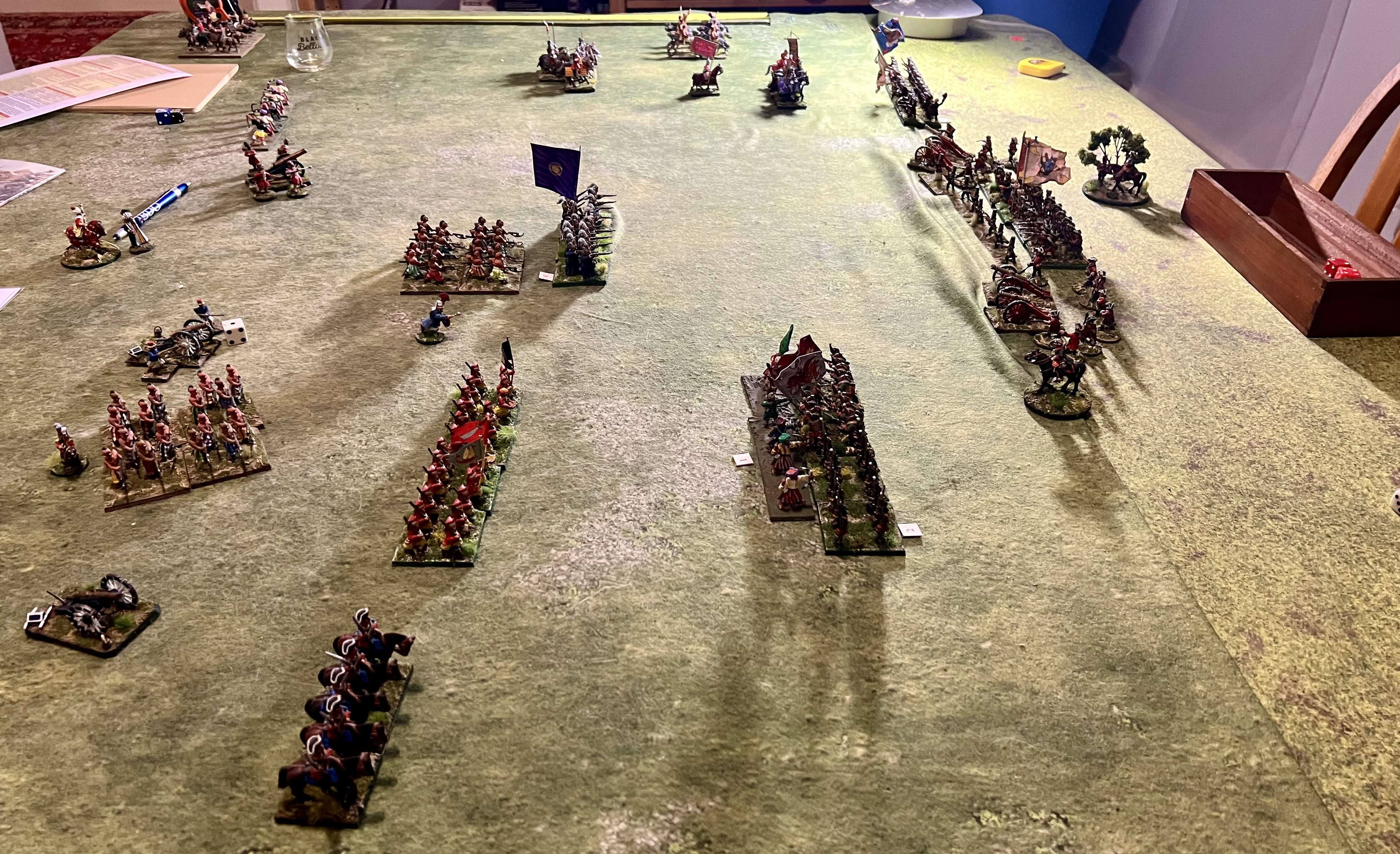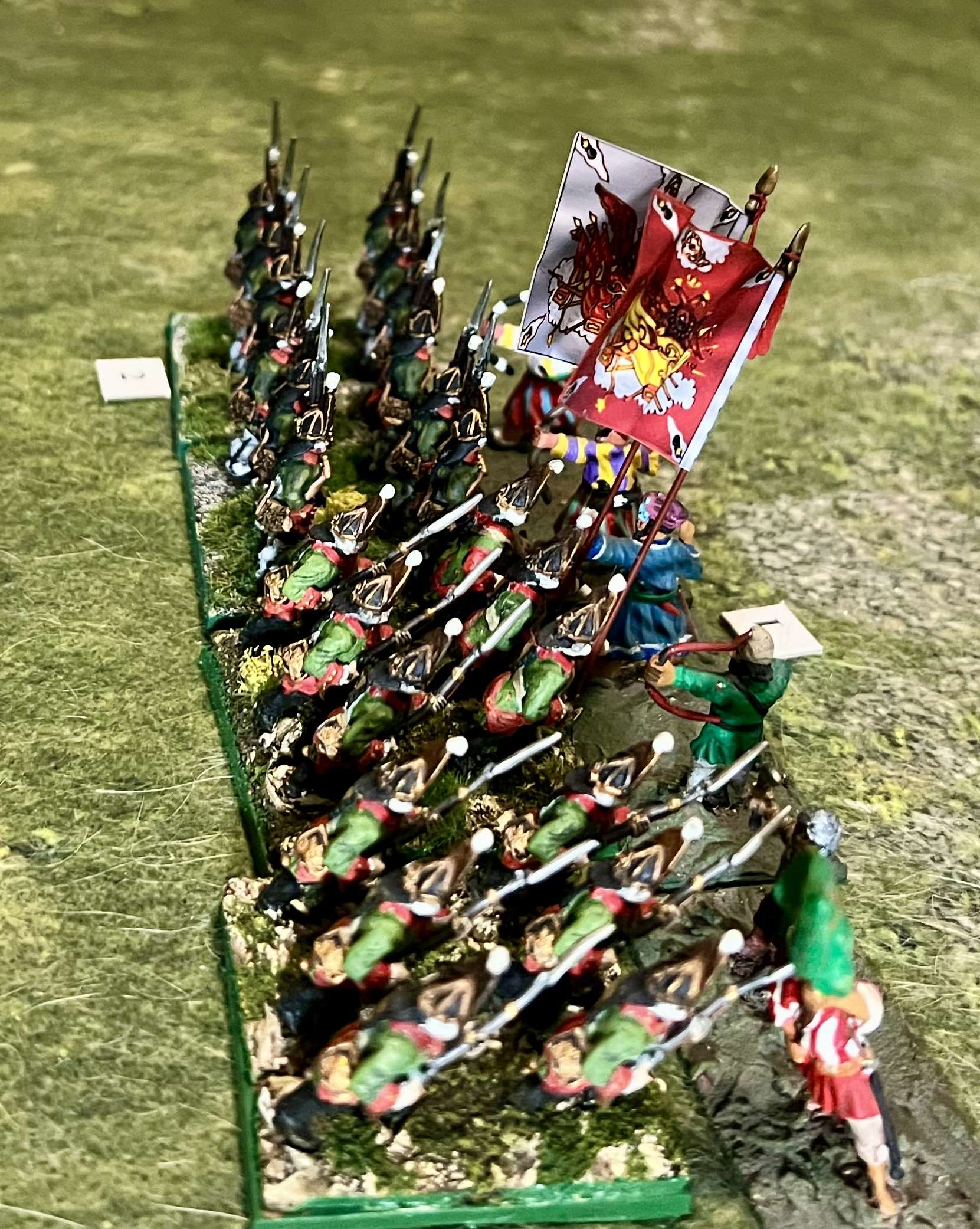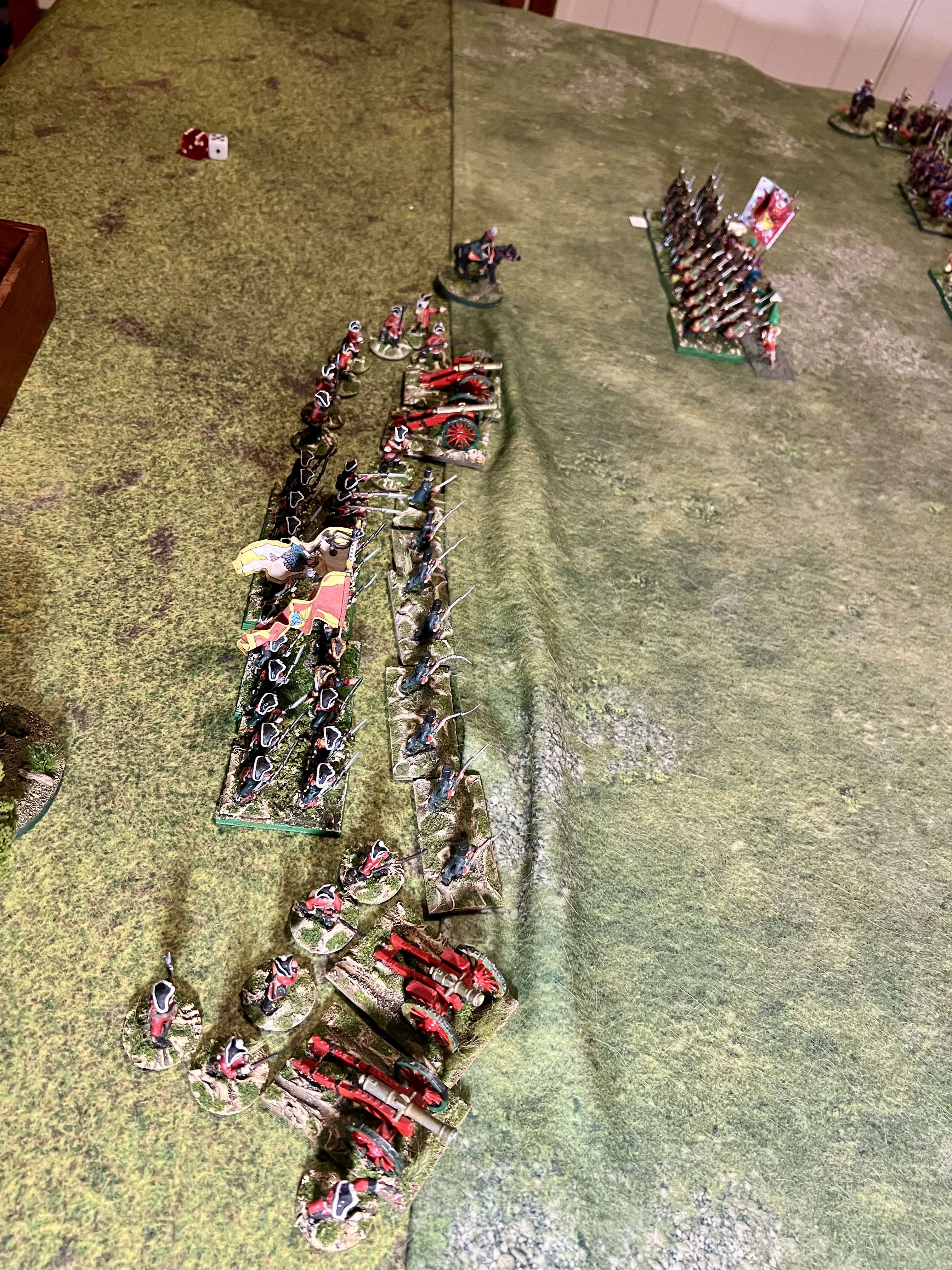Not that they are especially new, but I've spent the last few weeks learning a set of horse and musket rules by Henry Hyde called Shot, Steel and Stone (SS&S). I've been looking for a good set of rules suitable for the Seven Years War period, and added SS&S to my shopping cart when I was buying some books on the Caliver website. They are also available on the Wargames Vault webstore, and are fairly inexpensive.
My first impression of SS&S was that the subtitle, "The Bare Essentials", described it well. The black and white book weighs in at about twenty-ish pages but was attractively bound in a soft cardboard cover. The B&W photos show ranks of the old school figures that Henry unabashedly loves, and help give these rules their nostalgic feel. However, Henry's been busy augmenting these rules with a whole set of "how to" videos on his You Tube channel, done in his loquacious and enthusiastic style.
Since I had my Turkish 18th century army on the table (see my previous post here), I decided to put my Russian troops down and have a go. This may have been a mistake, as it's always better to learn a new set of rules with fewer units, but I couldn't resist the visual appeal. As you can see, I didn't put any terrain down, as I wanted to focus on the core mechanics.
Here are four things I especially liked about these rules.
1) Limited Friction. Commanders and subcommanders can have three ratings, basically Good, Average, and Poor, which determine their command radii and the bonuses they can give their troops. However, at the start of each turn, each commander's ability is checked by a die roll, meaning that even good commanders can have a bad moment, and vice versa. This effectiveness check imposes a limited friction on the battle, so that a bad roll means that a commander's units will move more slowly and be less reliable in melee, or (again), vice versa. Thus, a wing of the army will not lose a turn, as in some other rule sets where initiative rolls are required, but that wing might perform erratically to the good or bad.
2) Basing Agnostic. Like other rules sets, bases don't have to be of a certain size as long as the size is standard, and movement and range is measured in base lengths (my bases are generally 2 inch squares, so that's easy to work out). Unit strength is measured by a number of bases. Bases can be removed by shooting hits or by melee results. Large units have better morale than smaller ones, and generally when a unit gets to half its original strength, it's basically spent and will retire. Each base gets so many dice for shooting or for melee.
3) Morale System. In SS&S units have three levels of quality, A (elite), B (line) and C (poor). Morale checks are taken before charging, when being charged, after melee and after shooting hits are taken, etc. The quality of the unit and its size are among a range of factors that determine the morale check modifier, including: unit posture (eg, advancing or retreating), hits taken that turn, current size vs starting size, formation (eg, skirmish vs close order), threats to flank and presence and proximity of supporting units.
That sounds like a lot to calculate, and will remind older players of WRG rules sets and the days of yore, but Henry's supplied a clever little matrix that makes the process fairly easy to work through.
Of course, the dice will be perverse. Here my Elite (A Class) Russian grenadiers caught a unit of Poor (C Class) Ottoman skirmish bow in a charge and amazingly the skirmishers held their ground and fought the grenadiers to a standstill, with casualties tied on both sides. Of course, two of those grenadier bases were newly painted and having their first outing, so the new unit curse naturally applies.
4) Disruptions
Units can acquire Disruption points through events such as being charged by cavalry, crossing difficult terrain, routing, routers passing through, second round of melee, etc. Disruption points adversely affect morale checks and combat. Units that do nothing except halt and reform can remove two disruption points per turn.
Other things worthy of comment:
Shooting and Artillery:
The shooting rules seem well thought out. Musket armed infantry, the queen of the 18th century battlefield, are pretty effective (3 dice per base) whereas skirmish troops get one dice per base. Shooting, like morale, is reminiscent of WRG, with modifiers awarded or denied based on firer's troop quality, target density, first volley, and so forth. However, hits do not become kills automatically; the targeted player gets a saving throw for each hit. One blogger who was also reviewing SS&S said that he was inclined to jettison the saving throw for solitaire play, but that he would keep it for FTF gaming as it adds some fun and uncertainty. Seems fair.
One thing I did learn was that artillery is pretty deadly, especially at short range, and smoothbore artillery hits can only be saved on a 6 on 1d6. Because I had put all my SYW models on the table, the Russians had four guns (see photo below), which were able to chew up an advancing unit of janissaries long before they got within range. I would keep the artillery to a minimum.
Horse, especially shock cavalry, are potent but can be seen off by good order infantry in line. In Henry's rules, there is no need for 18th century infantry to go into square, though fighting the pesky Turks with their light cavalry hordes, I could see the wisdom of the Russian practice of the divisional square. Here, some Russian musketeers, with artillery support, see off armoured spahis. Evade moves:
Light and skirmish troops have the option to take Evade moves, though I found this a little confusing and wished that the rules had an index as it took me a while to track this down.=. Evaders need to pass a morale test if charged (I think, I need to reread the rules) and then have the opportunity to take a full move with an evade bonus, or shoot (with a move penalty) and evade. With the Ottoman skirmish horse archer units, for example, they pretty much evade automatically, so they were mostly ineffective but pesky. I decided that iuf they were to evade, it must be a full evade move straight toward their friendly table edge, and if that took them off the table edge, too bad. One could house rule this so that they were lost if they evaded off the table, or took a full turn to regroup before entering the next turn.
Of course, another approach would be for the Ottomans' opponent to have sufficient light cavalry to keep the skirmish horse away! As it was, with only one hussar unit on the table, the Russians found the skirmish horse quite annoying.
Some final points. Besides his YouTube channel that I've already mentioned, Henry is very active on social media (he's on Bluesky - @battlegames.bsky.social) and today he just posted some errata and clarifications. Henry also has a Facebook page for SS&S where he has been good about answering questions, so these rules are very well supported by the author, and are obviously his passion project. That's a huge plus for me.
While I've written about these rules through my own lens of SYW interest, Henry is clear that they could easily work with Napoleonics, and there are some modifiers and rules (eg infantry squares) that are specifically for that period. SS&S also includes rules for fighting in built up areas which would allow for some siege battles, as well as a colonial section, so it's quite versatile.
While there are other SYW rules that I want to explore (eg, Keith Flint's Honours of War), I will happily try SS&S again, and think with a little investment in time it could serve well. Any game with five pages of charts and tables will require that sort of investment, so I would say it's more for grognards than beginners, especially those of us who remember the WRG days and secretly miss them, but the rules seem fun and playable.





Excellent overview of the rules, Michael. If a game cannot be played from one double-sided 5" x 7" QRS then it may be too much for me to remember in the heat of battle.
ReplyDeleteHoW is a terrific set of SYW rules as is my favorite, Fields of Honor.
Thanks Jon. Curiously today I just received the new 2nd ed of General d'Armee by TFL/Reisswitz Press and it comes with two double sided letter sized QRS. I suppose there's an correlation between number of sheets of QRS and hours necessary per game.
DeleteI need to check out Fields of Honor.
Cheers, M
A nice review there Michael and like Jon above, any ruleset with more than a double sided QRS is too much IMHO. At a recent meeting a participant came up with the great phrase of: "Anything with a staple in it is too long!".
ReplyDeleteI may be biased as Keith Flint is a good friend of mine, but Honours of War are a great set of rules and my default 'go to' for the 18thC.
Thanks Steve. Not sure about the no staple philosophy, but the Neil Thomas One Hour Wargame approach has some merit. I've only tried HoW once and need to revisit it since the SYW bug has gripped me! Some friends of mine here in Canada are enjoying. it.
DeleteMichael, thanks for your review of the rules. There is a place for rules like these, looking over our shoulders at the past and to the best part of the future.
ReplyDeleteThanks sir. "There is a place for rules like these, looking over our shoulders at the past and to the best part of the future" I really like how you put that.
DeleteThis comment has been removed by the author.
ReplyDelete